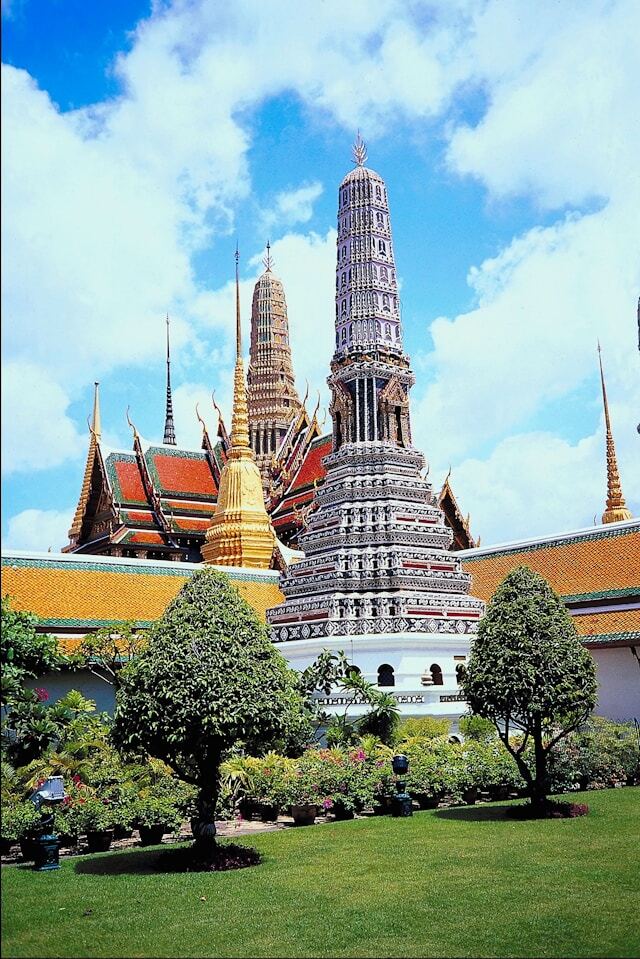A Majestic Journey Through Thai History and Grandeur
The Grand Palace in Bangkok stands as a testament to Thailand's rich history and cultural heritage. This iconic landmark, once the official residence of the Kings of Siam, encapsulates centuries of tradition within its walls.
As you prepare to journey to Bangkok, immersing yourself in the splendour of The Grand Palace is a must-do experience. From intricate architectural details to revered spiritual significance, every corner of this grand complex tells a story of Thailand's past and present.
Travellers seeking a glimpse into the opulent world of Thai royalty will find themselves captivated by the intricate beauty of The Grand Palace. Be prepared to be awestruck by the ornate structures that symbolise the grandeur and prestige of the Thai monarchy.
Exploring The Grand Palace offers a profound insight into the cultural tapestry of Thailand. As you wander through the majestic halls and sacred temples, you will feel the echoes of history reverberate through this magnificent site, leaving an indelible mark on your journey through Bangkok.
Prepare to be enchanted by the vivid colours, intricate designs, and spiritual significance that embody The Grand Palace. Whether you are a history buff, a cultural enthusiast, or a curious traveller, this timeless landmark promises an unforgettable experience that resonates with the soul of Thailand.
Exploring the Grand Palace in Bangkok
The Grand Palace in Bangkok holds a rich tapestry of history that dates back to the founding of the city itself. As the official residence of the Kings of Siam, this iconic landmark has witnessed centuries of royal ceremonies, governmental functions, and cultural celebrations, making it a must-visit destination for travellers seeking to explore Thailand's royal heritage.
History of The Grand Palace
The origins of The Grand Palace can be traced back to 1782 when King Rama I decided to establish Bangkok as the new capital of Thailand. Built on the eastern bank of the Chao Phraya River, The Grand Palace served as the royal residence and administrative headquarters for generations of Thai monarchs. Its architecture reflects the deep reverence for traditional Thai design and religious symbolism, embodying the spiritual and cultural essence of the nation.
Architecture and Design
The architecture of The Grand Palace is a mesmerising blend of Thai aesthetics and European influences, characterised by intricate details and vibrant colours. The ornate spires, golden stupas, and glistening mosaics transport visitors to a world of opulence and grandeur. Each building within the complex tells a story of craftsmanship and devotion, showcasing the artistic prowess of Thai artisans through the ages.

Must-See Attractions within The Grand Palace
Visitors to The Grand Palace are greeted by a treasure trove of architectural wonders and cultural landmarks. From the revered Emerald Buddha Temple to the dazzling Grand Palace Museum, each corner of the complex unveils a new facet of Thailand's royal legacy. The Phra Thinang Chakri Maha Prasat, with its blend of Thai and European architectural styles, stands as a testament to the palace's enduring elegance and historical significance.
Whether marvelling at the intricate frescoes adorning the walls or strolling through the manicured gardens, exploring The Grand Palace is a journey through time and tradition, offering a glimpse into the heart of Thailand's cultural identity.
Visitor Information and Tips
When planning a visit to The Grand Palace, it's essential to be well-prepared with all the necessary information to make the most of your experience.
Opening Hours and Ticket Prices
The Grand Palace is open every day from 8:30 am to 3:30 pm, with last entry at 3:00 pm. It's recommended to arrive early to avoid crowds and fully appreciate the beauty of this historic site. Ticket prices for adults are 500 Baht, and for children under 130 cm tall, the entry is free. Remember to carry cash for ticket purchases as credit cards may not be accepted on-site.
Dress Code and Cultural Etiquette
Respecting the Thai culture is crucial when visiting The Grand Palace. To enter the grounds, visitors must be dressed modestly with no bare shoulders, knees, or midriffs. Wearing comfortable and breathable clothing is advisable due to the tropical climate of Bangkok. Embracing the local customs by removing hats and shoes before entering the sacred sites shows reverence for the Thai traditions.
Guided Tours and Self-Exploration
While exploring The Grand Palace on your own allows for flexibility, opting for a guided tour can provide valuable insights into the history and significance of the palace complex. Knowledgeable guides can uncover hidden gems and share captivating stories that enhance your visit. Consider joining a guided tour to make the most of your time and gain a deeper understanding of the cultural heritage preserved within The Grand Palace.
For more practical information and to plan your visit effectively, check out these helpful resources on The Grand Palace.
Remember, immersing yourself in the rich history and cultural splendour of The Grand Palace promises an unforgettable journey through Thailand's royal legacy.
Experiencing the Grand Palace's Splendour
Stepping into the realm of the Grand Palace in Bangkok is like immersing yourself in a world where culture and heritage intertwine seamlessly, offering travellers a glimpse into Thailand's majestic past. The Grand Palace stands as a symbol of Thailand's grandeur, showcasing exquisite architecture and intricate designs that leave visitors in awe.

Cultural Festivals and Events
Dive into the rich cultural tapestry of Thailand by attending special cultural festivals and events hosted at The Grand Palace. From vibrant ceremonies to traditional celebrations, each event offers a unique insight into the local customs and traditions that have been preserved for centuries. Witnessing these cultural spectacles provides travellers with a deeper appreciation of Thai heritage and a memorable experience that resonates long after the visit.
Nearby Attractions to Explore
After exploring the opulence of The Grand Palace, travellers can continue their adventure by exploring other nearby attractions that enhance their travel experience in Bangkok. From the serene Wat Pho with its famed reclining Buddha to the bustling markets of Chinatown, there is no shortage of exciting places to visit in the vicinity. By delving into these attractions, visitors can gain a comprehensive perspective of Bangkok's diverse offerings and create lasting memories of their time in this vibrant city.
Immerse yourself in the splendour of The Grand Palace and discover a world where history and culture converge to create an unforgettable travel experience.
For more information on upcoming cultural events in Bangkok, visit Bangkok Tourism Board.
Preserving the Heritage of The Grand Palace
The Grand Palace stands as a testament to Thailand's rich history and cultural heritage, captivating visitors with its architectural splendour and historical significance. Preservation efforts play a crucial role in maintaining this iconic landmark for future generations to appreciate.

Conservation Efforts and Restoration Projects
Dedicated conservation projects are meticulously carried out to ensure the longevity of The Grand Palace's architectural marvels. Skilled artisans and experts work tirelessly to preserve intricate details, vibrant colours, and delicate structures that define the palace's grandeur. Through meticulous restoration, centuries-old buildings and artefacts are safeguarded against the ravages of time, allowing visitors to witness the palace in all its former glory.
Educational Outreach and Cultural Significance
Educational initiatives surrounding The Grand Palace serve as a gateway to Thailand's rich cultural tapestry and historical narratives. By engaging visitors in the palace's cultural significance, educational programmes offer insights into Thai history, art, and traditions. This immersive experience not only educates but also fosters a deeper appreciation for the country's heritage, bridging the gap between the past and present. The Grand Palace plays a pivotal role in promoting Thai history and cultural heritage to a global audience, showcasing the nation's legacy on an international stage.

Conclusion
In conclusion, The Grand Palace stands as a timeless symbol of Thailand's rich history and cultural heritage. As the official residence of the Kings of Siam since 1782, this architectural marvel continues to captivate visitors with its intricate designs and historical significance. The allure of The Grand Palace as a must-visit destination for travellers planning a trip to Bangkok is undeniable. From the majestic Temple of the Emerald Buddha to the grandeur of its ceremonial halls, every corner of The Grand Palace exudes a sense of grandeur and reverence. Immerse yourself in the beauty and legacy of The Grand Palace, and experience the essence of Thailand's royal past in this extraordinary landmark.
The Grand Palace FAQ
What are the opening hours of The Grand Palace?
The Grand Palace is open daily from 8:30 am to 3:30 pm. It's wise to get there early as it can get quite busy, especially during tourist season.
How much does it cost to enter The Grand Palace?
The entry fee for foreign tourists is approximately 500 THB per person. This fee includes access to the Temple of the Emerald Buddha and the Royal Thai Decorations & Coins Pavilion within the palace grounds.
What should I wear when visiting The Grand Palace?
Visitors must dress modestly. Men should wear long pants and shirts with sleeves. Women should avoid see-through clothes, sleeveless tops, and short skirts or shorts. It's all about respecting the cultural norms.
Can I take photos inside The Grand Palace?
Yes, photography is allowed in most areas of The Grand Palace. However, photography is strictly prohibited in some sections, especially inside the Temple of the Emerald Buddha. Always look out for signs and follow the rules.
Are guided tours available at The Grand Palace?
Yes, guided tours are available and can greatly enhance your visit by providing deeper insights into the history and significance of the site. You can book these tours on-site or in advance through various travel agencies.
What is the best time of year to visit The Grand Palace?
The best time to visit is during Bangkok's cooler months from November to February. The weather is more pleasant, making your exploration of the grounds more comfortable.
Is The Grand Palace wheelchair accessible?
Certain areas of The Grand Palace are accessible by wheelchair, but some of the older sections might be challenging due to uneven surfaces. Wheelchair rental services are available at the entrance.
Can I bring food and drinks into The Grand Palace?
No, food and drinks are not allowed inside The Grand Palace. However, there are several eateries just outside its gates where you can grab a bite before or after your visit.
What is the least crowded time to visit The Grand Palace?
To avoid the crowds, aim to visit early in the morning right when it opens, or on weekdays rather than weekends. This way, you'll have a more relaxed experience and better photo opportunities.
How long does a typical visit to The Grand Palace take?
Most visitors spend between 1 to 3 hours at The Grand Palace, depending on their interest level and whether they choose to join a guided tour. Plan to spend at least half a day in the area to fully appreciate its beauty and significance.




